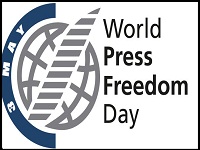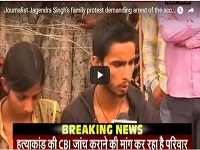Journalist murders in regional media

Reprinted from Scroll.in
Last week, television journalist Akhilesh Pratap Singh was shot dead in Chhatra, Jharkhand. Barely than 24 hours later, in neighbouring Bihar, Rajdeo Ranjan, Siwan bureau chief of Hindi daily Hindustan, was gunned down in Siwan.
The murders have exposed the faultlines in the media, not least the most basic, which is the ability to access and swiftly disseminate authentic information.
Journalists scrambled to get information on the two incidents. In the absence of independent information, political parties quickly stepped in and traded allegations on the breakdown of law and order in Bharatiya Janata Party-ruled Jharkhand and Bihar, where the Rashtriya Janata Dal is part of the coalition government.
Meanwhile, five days on, no clear motives have emerged with regard to either of the killings.
Political games
Three journalists have been murdered in India this year. On February 13, Karun Mishra, the bureau chief of newspaper Jan Sandesh was shot dead by unidentified persons in Sultanpur, Uttar Pradesh. Five days after the incident, Chief Minister Akhilesh Yadav ordered a probe and police arrested five persons from the mining mafia.
Akhilesh Singh, locally known as Indradev Yadav, was a journalist with a news channel. Unidentified persons gunned him down at Dewaria in Chatra district of Jharkhand that borders Bihar and where a faction of a Maoist group called the Tritiya Prastuti Committee is active. The group, police said, indulges in extortion of money for petty contractors and local businessmen.
On Monday, police claimed a breakthrough in the case, arresting two persons. On Tuesday, a third person– Suraj Sao, the aide of BJP MLA Ganesh Ganjhu – was detained. The police said the journalist also took up civic works on contract and was killed over a dispute with members of the TMC and the MLA’s aide over the levy of money to be paid in exchange for a contract awarded to him. The police have discounted the involvement of the MLA in the killing.
But less than a day later, when news came in of the murder of Rajdeo Ranjan, the BJP were quick to denounce the “Jungle Raj” in Bihar.
In March, a photograph of jailed RJD leader Mohammad Shahabuddin sharing snacks with Bihar minister Abdul Ghafoor inside Siwan jail went viral. Rajdeo Ranjan was reportedly behind the leak. According to BJP leader and former Bihar chief minister Sushil Kumar Modi, Ranjan’s murder was revenge.
While police are still investigating the charge, Ranjan’s wife Asha Yadav has gone on record to say that her husband was killed for a series of news reports against Shahabuddin's interests. She further claimed that Ranjan figured on Shahabuddin’s “hit list”, which police were privy to at least two years ago. Fellow journalists were divided on these claims, but said there was definitely more to the murder than meets the eye.
On Monday, Bihar chief minister Nitish Kumar announced a Central Bureau of Investigation (CBI) probe into Ranjan’s death, even as the motive for his murder remains unclear.
Existing gulf
Almost every time a journalist is murdered in India – 29 since media watch website The Hoot began tracking free speech violations in 2010 – there is the involvement of politicians or local business people or the oil, timber and sand mafias, or those involved in illegal felling of forests, land grabbing, exploiting child labour, chit fund scams, or even cases of medical negligence.
By now, that’s a given.
It’s after the killing that a pattern quickly emerges. When journalists are attacked or killed, the struggle for justice begins with determining whether they are journalists at all, whether they died for their journalism and not owing to any “personal” dispute or business links. Before the crucial questions of who killed them and why can be asked, the case is over.
There currently exists a gulf between the journalists employed on contract in mainstream media and journalists who work independently or are associated as stringers with local or national newspapers and broadcast channels. Unprotected and unorganised, the plight of journalists in the regional media is much more precarious.
While the nexus between local politicians and business interests is hardly surprising, what is disturbing is the role of media houses in refusing to acknowledge these foot soldiers. Often, the mainstream media publications they may work for or contribute regularly to, may wash their hands of them, denying completely – even in the face of incontrovertible evidence – their employment, that they worked for them or had anything to do with them.
The dirty secret in the media is the manner in which journalists are constrained to work as advertising agents too. Often, the commissions they earn from advertising may be more than their salaries, points out senior journalist and media analyst Anil Chamadia, who worked for years in Bihar before he shifted to Delhi to set up a media watch organisation, People’s Media Group.
Discredited as journalists for working as advertising agents, they occupy a grey zone in an already fractured mediascape. It becomes far easier to isolate and target them when their journalistic reports ruffle the feathers of local power centres, politicians and businessfolk. Shooting these messengers of unsavoury and unflattering information, who refuse to remain plaint and push invisible boundaries, also serves another purpose – it will silence others as well.
Those responsible also know that they can get away with it. They can easily prevail upon local police and administration to drag their feet in the investigation. Is it any wonder that demands are now routinely made for a CBI probe in almost every instance? Invariably, the poor investigation, compounded by interminable trials, end up in acquittals. In all the killings of journalists so far, there has not been a single conviction.
And the struggle to secure some justice for their killings, left to family members or colleagues, becomes a long and solitary battle.
Geeta Seshu is an independent journalist and consulting editor to the Hoot.








